|
Introduction
- Although castor plant (Ricinus communis) serves
as an important source of raw material for many industries
and is reported to suffer severe losses due to many
diseases caused by fungi and bacteria.
- Some of the diseases are.
 Top
Top
Seedling Blight
- The disease is known to exist in India since 1909 when
it was reported from Pusa, Bihar.
- It generally appears during rainy season, i.e., about the
end of June and continues up to September.
- The disease is severe in low lying and badly drained fields
and it is in such areas that it destroys nearly 30-40 per
cent seedlings particularly those which are 6-8 inches high.
- The disease has also been reported from Uttar Pradesh in1948
and from Hyderabad in 1947.
Symptoms
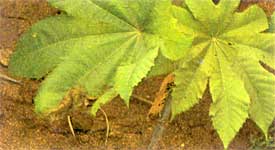 Dead seedling
Dead seedling |
- The disease first makes its appearance on both the surfaces
of the cotyledonary leaves in the form of roundish patch of
dull green colour which soon spreads to the point of attachment
causing the leaf to rot and hand down.
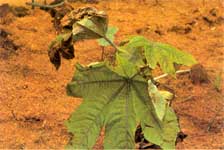
Spot on older leaf |
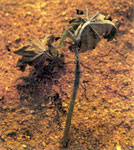
Leaf blight symptom
|
- The infection further spreads to the stem with the result
that the seedling is killed either due to the destruction
of growing point or by the collapse of stem.
- The true leaves of seedlings and the very young leaves of
older plants may also be affected; but ordinarily not much
injury is caused.
- The leaf spots turn yellow and then brown and concentric zones
of lighter and darker brown colour are formed.
- The outer border is not well defined and is greenish above
and brownish-grey below.
- The disease spots coalesce at a later stage and cover almost
the entire leaf.
- The presence of veins, even in the mature leaves, does not
obstruct the spread of the disease.
- The affected leaves shed prematurely. Under moist conditions,
a very fine whitish haze is found on the under-surface of
the leaf spots.
- In case of mature plants also the disease may spread from
young leaves to the stem through the petiole.
- When the older leaves are attacked the pathogen however remains
localised on the leaf blade.
- Direct attack of stem is not very common and if it is attacked,
the disease does not cause much damage.
- This has been considered to be due to the presence of cuticularised
epidermis in older stem which resists penetration.
- Infection of flowers and green fruits in nature has not been
reported though under laboratory conditions these parts get
infected.
Etiology
- The causal organism, Phytophthora colocasiae.,
consists of inter and intra-cellular mycelium which
develops inside the host tissue.
- After a few days growth numerous branches emerge from the
lower epidermis of the leaf generally through stomata as sporophores
either singly or in twos or threes.
- A single colourless ovoid or roundish sporangium is borne
at the tip of sporophore.
- A ripe sporangium liberates zoospores when put in water.
- The number of zoospores varies from 5 to 45 in each sporangium.
The zoospores germinate readily by one or rarely two germ
tubes.
- These are formed freely during hot and dry months when sporangia
are scanty and retain the power of germination for many months.
- Oospores have also been produced on artificial cultural media.
- The oospores remain viable for a long period and it is considered
possible that these might serve as a source of carrying the
parasite over from one crop to the next.
- Secondary infection spreads rapidly through sporangia provided
the weather conditions are favourable.
- The sporangia are easily disseminated by the wind and germinate
readily on the leaves producing zoospores which penetrate
by means of germ tubes either through stomata or directly
and produce diseased spots within 24 hours and the next crop
of sporangia appear in about two days.
- The fungus also causes infection on young potato, tomato and
brinjal plants and seedlings of several garden annuals.
- It also produces infection on the leaf of Sesamum.
- These plants might serve as collateral or alternative hosts
of the fungus and help in the perpetuation of the disease.
Control
- Ill drained, damp and low lying localities should be avoided
for sowing castor.
- Seed dressing with 4gms g Trichoderma viride formulation and
3g metalaxyl per kg seed can reduce disease incidence. Soil
drenching with copper oxychloride @3g /lit or metalaxyl 2g/lit
is also useful.
 Top
Top
Alternaria
Blight : Alternaria ricini Y
- The disease has been reported from different parts of
the country from time to time and is assuming serious proportions
in the recent years particularly in Bombay areas.
- In some other countries also, Alternaria leaf spot is considered
to be one of the serious diseases of castor.
- In humid years extensive fructification of the fungus takes
place on the capsules of castor plant giving black, sooty
appearance which on shaking gives rise to black clouds of
conidia.
- In some fields about 70 per cent of the plants are reported
to be affected with the disease causing serious losses in
yield and oil content.
- When the infection takes place in early stages of flower development
the buds are killed and the inflorescence turns black.
- If the disease appears at a late stage, the flowers shed without
capsule formation and in mild attack only individual flowers
dry up.
- The height and general vigour of seedlings were reduced due
to the disease which affected the yield to a considerable
extent
Symptoms
|
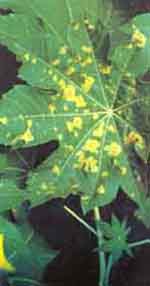
Alterneria leaf spot with concentric rings
|
-
All the aerial parts of the plant, i.e., stem, leaves,
inflorescence and capsules are liable to be attacked.
- The disease first makes its appearance on the cotyledons
in the form of spots and if the infection is extensive,
the plants become stunted and ultimately die.
- The spots on the leaves are seen throughout the year
and become more extensive during rainy season.
- These may appear on any portion of the leaf and are
irregular, scattered, and have concentric rings.
- These are brown and later become covered with bluish-green
or sooty growth.
- When the attack is severe the spots coalesce and form
big patches resulting in premature defoliation of
the plant which gradually wilts away.
- The inflorescence and the capsules are also attacked
and get covered partially or fully with a similar
sooty growth.
- Two types of symptoms may be observed on the capsules.
|
- In one case the capsules, when half mature, wilt
suddenly,turn brown and due to collapse of the
pedicel the capsules fall or hand down.
- They are smaller in size and have under-developed and wrinkled
seeds with little oil content.
- The germination of the affected seeds is also adversely affected.
- In other case, the attack is generally on the fully developed
capsules resulting in the appearance of sunken spots on one
side of the capsule which gradually enlarge to cover the whole
pod with characteristic growth of the fungus.
- The pathogen may infect the seed if the capsule cracks.
- Stem of the castor plant has also been reported to show symptoms
of the disease in some of the exotic varieties.
Etiology
- The disease is caused by Alternaria ricini.
The conidia are produced abundantly on the diseased
portion under moist conditions and borne in chains on
the conidiophores.
- The conidiophores are straight, erect or irregularly bent,
sollitary, sometime in fascicles and are olivaceous in colour.
- The conidia are obclavate, light olive in colour but become
darker in mass.
- They are segmented into 5-16 cells with transverse and longitudinal
septa with and without beak.
- The beak is narrow, colourless, long and unbranched.
- The conidia formed in culture are usually smaller in size
than those formed on the host.
- The disease is carried over through the seed both externally
and internally.
- It is reported that the disease causes pre and post-emergence
damping off and a seedling and foliage blight when the diseased
seeds are sown.
- Some of the conditions which govern the severity of the disease
are reported to be the presence of a susceptible variety,
high atmospheric humidity and low temperature (16-200 C).
Control
- Seed treatment may be useful in combating the initial
phase of the disease.
- Use of healthy seed and treat the seed with Captan or Thiram
@ 3g/kg seed or spray Mancozab at 2.5g/lit concentration at
an interval of 15days commencing from 90days of crop growth.
 Top
Top
Rust
- The disease occurs in Bombay, Deccan districts, Coimbatore
and Nagpur.
- It usually appears in Bombay between November and February
on castor sown in June.
- The damage caused by this disease was very severe in moist
localities and at places where the disease appeared quite
early.
- In Hyderabad the disease appears only in December when the
capsule formation has already started so that little damage
is done to the crop.
Symptoms
 Powdery mass covering entire leaf
Powdery mass covering entire leaf
|
- The disease
appears in the form of rust pustules on the under
surface of the leaves.
- The uredopustules are often grouped in small circles
and two or more may coalesce to form bigger patches.
- The pustules burst at a later stage exposing the powdery
mass of uredospores which are orange-yellow in colour.
|
- The under-surface of the leaf is marked by the corresponding
small roundish yellow spots.
- In severe attacks practically every leaf is densely covered
with rust pustules with the result that leaves may get dried
up and wither prematurely.
Etiology
- The hyphae of the causal organism (Melampsora ricini)
collect beneath the epidermis of the leaf and form a
minute cushion.
- The uredospores arise beneath the epidermis on the tips of
branched hyphae.
- Stout club-shaped paraphyses are also formed in the sorus.
- At maturity the epidermis ruptures releasing clouds of spores.
- The uredospores are round or elliptic, warty and orange in
colour and measure 25-29 X 19-25u.
- They germinate by germ tube which comes out from the pores
and infects fresh leaves of castor.
- It was observed that the rust culture could not be maintained
on host plants under Delhi conditions beyond the beginning
of April because of rise in temperature.
- Melampsora ricini is pathogenic to Euphorbia obtusifolia,
E.ipecacuanha, E. giniculata and E.marginata besides
24 strains and varieties of R.communis.
- Isolates of M. euphorbiae from 5 species of Euphorbia including
E.peplus failed to infect castor.
Control
- The disease is reported to be successfully controlled
by spraying the crop with fine sulphur powder @20-30kg / hec.
- Spraying of Tridemorph 1 ml/litre of water or Mancozeb 2.5
g/litre of water minimises disease spread.
 Top
Top
Cercospora Leaf Spot
- The disease has been reported from Bihar, Uttar Pradesh
and Hyderabad and is probably present in many other parts
of the country.
- It causes considerable injury to the leaves and is the source
of loss of food for the Eri-silkworm which is maintained on
castor plant.
Symptoms
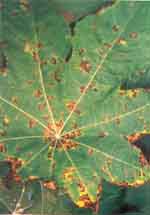 Spots on leaf
Spots on leaf |
- The disease appears as minute black or
brown points surrounded by a pale green ring.
- These spots are visible on both the surfaces of the
leaf.
- As the spots enlarge, the centre turns pale brown
and then greyish-white surrounded by a deep brown
band which may be narrow and sharp or broad and diffused.
- The fructifications of the fungus appear as tiny black
dots in the white centre.
- The diseased spots often occur in great numbers scattered
over the leaf and are roundish when young but may
become irregularly angular when mature.
- When the spots are close together, the intervening
leaf tissue withers and large brown patches of dried
leaf may result.
|
Etiology
- The disease is caused by Cercospora ricinella.
The hyphae of the causal organism collect beneath the
epidermis and form very small stomata.
- Clusters of conidiophores usually in groups of 10-20 emerge
through any part of the leaf tissue and form the fructification
of the fungus.
- The conidiophores are brown below and lighter towards the
tip and are septate, unbranched and measure from 24 to 70
by 3 to 6.5u. The upper part of the conidiophores is characteristically
knobby or flexed.
- The conidia are elongated, colourless, tapering above and
truncated below, straight or slightly curved, multiseptate
(upto 7 transverse septa).
Control
- Spraying with Bordeaux mixture or other copper fungicides
may help to bring the disease under check; but where the cultures
of Eri-silk worm are maintained on castor plants, spraying
would not be desirable.
- Use of resistant varieties would be the most effective method
for combating the disease.
- Spraying twice with mancozeb 2.5g/lit or Carbendazim 1g/lit
at 10-15 day interval reduces the disease incidence.
- Treat the seed with Thiram or Captan 3gm/kg seed.
 Top
Top
Powdery Mildew
- The disease in India is reported to be prevalent during
November to March at Coimbatore.
Symptoms
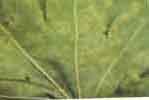 Powdery mass covering entire leaf
Powdery mass covering entire leaf
|
- It is characterised
by typical mildew growth which is generally confined
to the under-surface of the leaf.
- When the infection is severe the upper-surface is
also covered by the whitish growth of the fungus.
- Light green patches, corresponding to the diseased
areas on the under surface, are visible on the upper
side especially when the leaves are held against light.
|
Etiology
- The disease is caused by Leveillula taurica.
- The pathogen is endophytic and consists of hyphae which are
intercellular and occupy the spongy parenchyma of the mesophyll.
- The haustoria penetrate into some of the parenchymatous cells.
- The conidiophores of the fungus are branched and usually emerge
through stomata in aggregation.
- The conidia are hyaline, varying in shape, bear minute papilla-like
projection at the broad end, and are borne singly at the tip
of each branch.
- These germinate readily in water producing a germ tube from
one end.
- The fungus is also reported to produce powdery mildew
disease on Cyamopsis tetragonoloba, Capsicum annuum,
Medicago sativa and Vinca pusilla.
Control
- When weather is comparatively dry spray twice Wettable
Sulphur 3g/lit at 15 days interval , starting from 3 months
after sowing.
- Spray 1ml Hexaconazole or 2ml Dinocap /litre of water at fortnight
intervals. The variety jwala is resistant to this disease.
 Top
Top
Root rot
/ Charcoal Rot / Die back : Macrophomina phaseolina
Symptoms
|
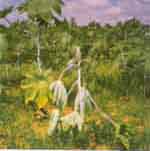
Affected plant showing drooping of leaves
|
-
Small brown depressed lesions on and around nodes.
- Increase in size on both directions causing 2 to 20
cm necrotic area
- Lesions often collace and girdle the stem causing
leaf drop.
- Entire branch and top of the plant withers.
|
|

Infected dead plant
|
- Drying and
death starts from apex and progress.
- Infected capsules discoloured and drop easily.
- Sudden wilting of plants in patches under high moisture
stress coupled with high soil temperature.
- Plant exhibit symptoms of drought and drooping of
leaves.
- At ground level black lesions are formed on the stem.
- Young leaves curl inwards with black margins and drop
off later, such branches Die-back.
|
Control Measures
Cultural
- Grow tolerant and resistant varieties like Jyothi, Jwala,
GCH-4, DCH-30 and SHB-145.
- Avoid water logging.
- Destruction of crop debris.
- Selection of healthy seed.
- Providing irrigation at critical stages of the crop.
Chemical
- Treat the seed with Thiram @ 3g / Kg or carbendazim @
2g/ kg seed.
- Seed treatment with Trichoderma viridae formulation at 4g/kg
of seed .
- Soil drenching with Carbandazim(1g/1 litre of water) 2-3 times
at 15 days interval.
 Top
Top
Wilt : Fusarium oxysporum
|
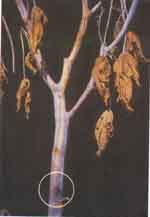
Sporodochia on stem
|

Infected seedling |

Drooping of leaves
|
|

Brownish
discoloration in
split open stem
|

whitish fungal
growth on seed
|
Seasonal Occurance
- Seedling to maturity. The disease appears in patches.
Symptoms
- When seedlings are attacked cotyledonary leaves turn to
dull green colour, wither and die subsequently.
- Leaves are droop and drop off leaving behind only top leaves.
- Diseased plants are sickly in appearance.
- Wilting of plants, root degeneration, collar rot, drooping
of leaves and necrosis of affected tissue and finally leading
to death of plants.
- Necrosis of leaves starts from margins spreading to interveinal
areas and finally to the whole leaf.
- Spilt open stem shows brownish discolouration and white cottony
growth of mycelia much prominently in the pith of the stem.
Control measures
Cultural
- Selection of disease free seed.
- Grow tolerant and resistant varieties like Jyothi, Jwala,
GCH-4, DCH-30 and SHB 145.
- Avoid water logging
- Burning of crop debris
- Green manuring and intercropping with Red gram
Chemical
- Treat the seed with Thiram @ 3g/ kg or carbendiazim @
2g/ kg seed.
- Seed treatment with 4g Trichoderma virirdae formulation.
- Multiplication of 2kg T.Viride formulation by mixing in 50kg
F.Y.M, Spinking water and Covering with polythene sheet for
15days and then applying between rows of the crops is helpful
in reducing the incidence.
 Top
Top
Gray rot : Botrytis
ricini
Symptoms
|

Inflorescence
covered by
greyish fungal
growth
|
- Initially
symptoms are small blackish spots on inflorescence
from which drops of yellow liquid may exude.
- Fungal threads which grow from there spots, spread
the infection and produce characteristic appearance
of affected receme.
- The disease is problematic when rains occur during
capsule formation and during prolonged we weather.
|
|

Spike covered
by gryish
fungal growth
|
-
Total plant parts like leaves, stem, flower and
capsules weathered.
- The effected flowers are rot and are covered by
gray coloured fungus.
- The disease spreads upwards infecting all flowers
and capsules.
|
|
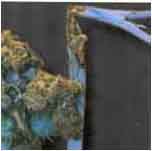
Breaking of
stem at point of
infection
|
- Blue spots
are appear on the branches and laterals of the spike.
- Affected parts are break off.
- Infection at the time of flowering results in flower
rot and affects seed filling.
- Infected capsules are rotted and shed off.
|
Favourable conditions
Night temperatures below 22oC followed by rains highly
favourable
Control measures
Cultural
- Use of non spiny varieties (48-1)
- Avoid excess irrigation
- Avoid close spacing
- Destruction of crop debris.
- Selection of variety with Non-spiny capsules and less compact
inflorescence like JWALA.
Chemical
- Spray Carbendazim (0.05%) or Thiophanate methyl (0.05%)
at 15 days interval.
- Seed treatment with carbendazim at 3g per kg and spraying
with carbandazim at 1g/lit depending on weather forecast atleast
6-8 hours before rain.
- Application of 20kg area and 10kg of Muriate of Potash after
removal of diseased panicles.
 Top
Top
Bacterial Leaf Spot
The disease has been reported from Bombay.
Symptoms
|
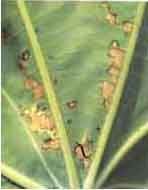
Pustules on lower
leaf surface
|
- The pathogen
attacks cotyledons, leaves and veins and produces
few to numerous small, round, water-soaked spots which
later become angular and dark brown to jet black in
colour.
- The spots are generally aggregated towards the tip.
At a later stage the spots become irregular in shape
particularly when they coalesce and areas around such
spots turn pale-brown and brittle.
- Bacterial ooze is observed on both the sides of the
leaf which is in the form of small shining beads or
fine scales.
|
Etiology
- The disease is caused by Xanthomonas ricinicola
, which is gram negative, liquefies gelatin, hydrolyses
starch, digests casein, peptonises milk, reduces litmus,
produces ammonia and hydrogen sulphide and does not
reduce nitrates.
- The optimum temperature for the growth of the bacterium and
its thermal death point are 31 0C amd 51 0 C respectively.
Control
Cultural
1. Field sanitation help in minimising the yield loss as
pathogen survives on seed and plant debris.
2. Hot water treatment of seed at 58oC to 60oC for ten minutes.
3. Grow tolerant varieties.
Chemical
- Spray Copper oxy Chloride(0.3%) or (500 PPM) Streptocycline
1g in 10 litres of water or Paushamycin (0.025%).
 Top
Top
|
